More on AMD’s XConnect Tech: Thunderbolt 3 for External Radeons
by Ryan Smith on March 10, 2016 9:00 AM EST- Posted in
- GPUs
- AMD
- Intel
- Radeon
- Thunderbolt
- Thunderbolt 3
- eGFX

Last night AMD issued a driver update that brought support for a new technology, XConnect. In a nutshell, XConnect is AMD’s trade name for running external video cards via Thunderbolt 3, a long awaited development that Thunderbolt owner Intel is finally getting behind and allowing. AMD’s driver release notes offered a handful of details, and now the official embargo for the tech is lifting, so we can fill in some of the blanks.
As our more observant readers may recall, when Intel unveiled Thunderbolt 3 back in June, they announced that they would finally be approving external video cards via Thunderbolt, and that they would be partnering with AMD to develop the initial implementation. More recently, at CES 2016 Razer unveiled the Razer Blade Stealth ultrabook, which was being immediately promoted as supporting external video cards, and was being shown off with its accompanying full power Core external video card chassis. Add the two up, and you can guess where this is going.
Today then is the formal launch of AMD’s Thunderbolt 3 video card efforts, which they are branding XConnect. The first drivers for XConnect were released last night, and now AMD is qualifying the Blade Stealth as the first laptop ready for XConnect. That said, it should be noted that while the Blade Stealth has been shipping for some time, Razer’s accompanying Core chassis has yet to ship, so anyone looking to try out XConnect will need to wait to get their hands on a Core.
Along with today’s formal unveiling of the technology, AMD is also laying out the technical requirements for supporting XConnect. Not just any laptop/desktop with Thunderbolt 3 can support an external GPU, as there are specific hardware and software requirements, which is why the Blade Stealth is the first qualified laptop. In particular, laptops need to support what is being called the Thunderbolt 3 external graphics standard, or eGFX for short. The eGFX standard in turn requires that vendors implement the necessary extensions for external graphics into their BIOS, including functionality necessary to support plug ‘n play operation. Also required is v.16 (or later) of the Thunderbolt firmware, Windows 10, and an active (not passive) Thunderbolt cable for bandwidth reasons.
With all of the necessary parts in play, from a technical perspective what we’re looking at is a somewhat more complex AMD Enduro switchable graphics setup, except with an external GPU. XConnect allows for an external video card to feed either a laptop’s internal display via the normal switchable graphics protocols, or an external monitor hooked up to the external video card. I dare say that much of this is mundane in 2016 as switchable graphics have been with us for some number of years now. What is novel here, as Intel told us as far back as June, is that what really changed their tune was that there is finally a sensible GPU hotplugging solution in place, allowing video cards to be added and removed without rebooting. This makes it much easier to use an eGFX solution – hence AMD’s focus on plug ‘n play functionality – and it means the operating system won’t crash and burn if an external video card is removed. Though from AMD’s whitepaper it’s clear that applications using the external GPU will likely crash, which is why external video cards still should be ejected for best results.
On the software side then AMD has gone ahead and implemented just this. The XConnect functionality in the latest Radeon drivers includes a system tray icon that that tells the user what applications are running on an external GPU, and can force close them if necessary to allow the GPU to be ejected/removed.
On the hardware side of matters, AMD is treating this as a high-end solution, and given the costs involved in Thunderbolt 3 I expect this will be the case universally. The company has qualified most of their high end graphics cards, including the R9 280, R9 290 series (sans 295X2), the R9 300 series, R9 Nano, and R9 Fury, while Fury X is excluded since its radiator won’t work with the Razer Core. Also supported are the mobile derivatives of these GPUs – for use in lower-power “graphics dock” devices – and future Polaris dGPUs will be supported as well. Overall from the GPU perspective Thunderbolt is just a higher latency PCIe 3.0 x4 connection, so it affords a lot of compatibility.
| XConnect GPU Compatibility List | ||
| Radeon R9 Fury | ||
| Radeon R9 Nano | ||
| Radeon R9 300 Series | ||
| Radeon R9 290 & 290X | ||
| Radeon R9 280 | ||
| Mobile dGPUs Based on the Above | ||
| Planned: Polaris dGPUs | ||
Meanwhile from a performance perspective AMD isn’t publishing specific numbers on how an external video card performs relative to an internal one, but PCIe 3.0 x4 testing is easy enough to do. With only one-quarter the bandwidth of a full PCIe 3.0 x16 slot Thunderbolt 3 will be constraining at times, but various benchmarks have put the average performance hit for a high-end card at under 10%. That of course will vary from game to game, as games that push a lot of data to the GPU or games that frequently interact with the GPU (e.g. retrieving physics simulation results) will be more greatly impacted by the reduced bandwidth and higher latency than simpler, more straightforward games.
From a broader perspective, the launch of Razer’s Blade Stealth laptop and Core chassis are part of what AMD hopes will be a much larger ecosystem for eGFX-capable laptops and enclosures. While each end needs to be certified, the fact that the transport layer is standardized Thunderbolt 3 means that any chassis should work with any laptop, and future solutions need not be a matching setup ala the Blade Stealth + Core. To that end Thunderbolt eGFX is not the first external graphics solution, but as a standard it has the potential to be more widespread than previous proprietary solutions such as MSI’s Shadow expansion dock or AMD’s own previous XGP initiative, not to mention it’s not tied to any one GPU vendor.
The catch, I suspect, will be getting laptop vendors to include Thunderbolt 3 support, as historically Thunderbolt has seen little traction outside of Apple laptops. The switch from the mini-Displayport connector to the USB Type-C connector is likely to help some with that, but a big consideration will be the space and power requirements of Intel’s Alpine Ridge controller, along with the costs of buying and integrating it.
As for the eGFX chassis, the Razer Core is a solid example of what to expect with high-end designs, which is a Thunderbolt dock on steroids. Along with providing enough power and space for a double-wide 375W video card, it also contains a Gigabit Ethernet port hanging off of the Thunderbolt controller’s PCIe lanes, USB 3.0 ports that are (presumably) coming off of the Alpine Ridge controller itself, and the ability to charge the Blade Stealth laptop. Back at IDF Intel was also pitching the idea for a smaller “graphics dock” concept, which would have a lower-power mobile-class dGPU integrated into a docking device that provided similar I/O functionality, to allow for a cheaper all-in-one device that provided a more modest boost to graphics performance.
Overall, gaming has been one of the few bright spots in an otherwise sluggish PC industry, and that goes for both gaming desktops and gaming laptops. For AMD and Intel, the launch of Thunderbolt eGFX/XConnect in turn allows them to further expand the gaming laptop market, moving beyond desktop replacement class laptops and more limited 15” laptops by offering desktop-class GPU performance to any laptop that incorporates a Thunderbolt 3 port and the necessary BIOS support. At the same time Ultrabooks themselves have been a steady and well received market, though making poor gaming devices due to a lack of space for a dGPU – never mind something that offers desktop-like performance. So after earlier efforts to pair them up with external graphics with any luck this will be the start of a viable gaming Ultrabook market as well.



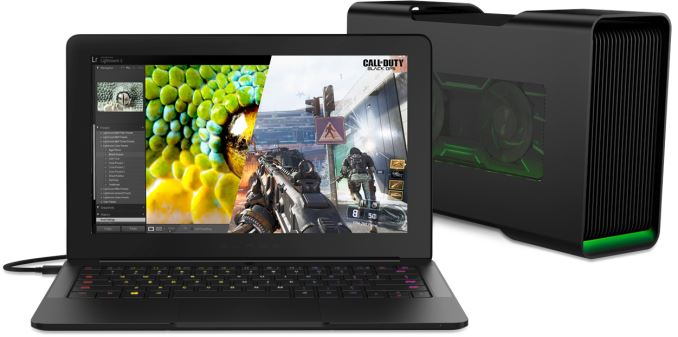
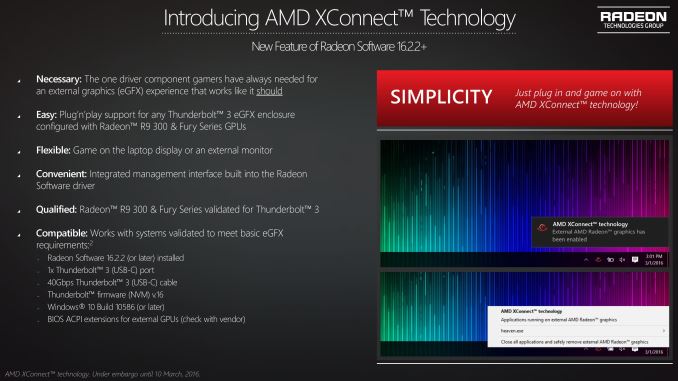
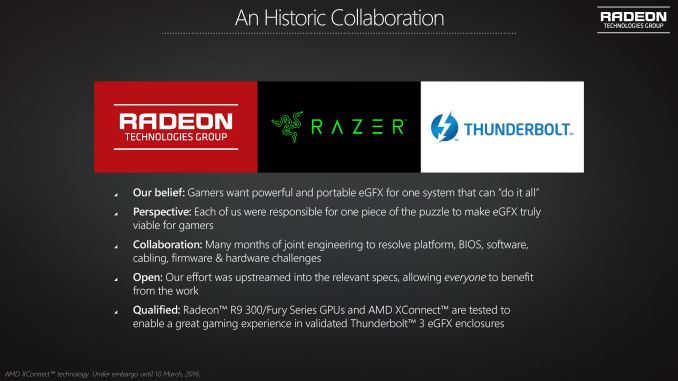
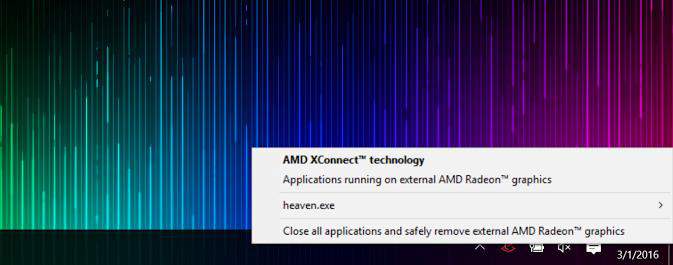

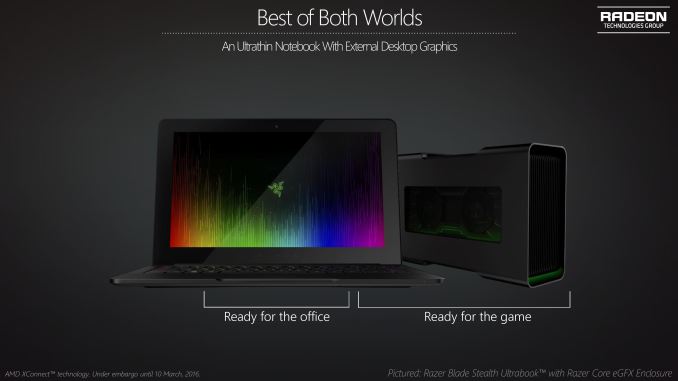














64 Comments
View All Comments
Laxaa - Thursday, March 10, 2016 - link
I wonder if MS will ever make an external GPU for the Surface Pro 4, seein as the Surface Connect port is PCI-E based(at least the one on the Surface Book is)tipoo - Thursday, March 10, 2016 - link
I also wonder if they'll upgrade the GPU in the keyboard of the Surface Book, that would be neat.Laxaa - Thursday, March 10, 2016 - link
Yeah. Like beeing able to just buy the base if you need more computing power. I don't think they'll get rid of the Surface Connect-port for a while.KoolAidMan1 - Thursday, March 10, 2016 - link
I expect it would be Thunderbolt 3 using a USB 3.1 port. Anything proprietary will be DOA. The dGPU in the Surface Book keyboard is a buggy, underpowered, overpriced mess that shouldn't have happened in the first place. Those external GPU enclosures are a much better solution.BrokenCrayons - Thursday, March 10, 2016 - link
This is good news from AMD since standard desktop systems are becoming progressively less commonplace, but dedicated graphics are still important to a lot of people who don't want to wait for iGPU performance to increase with each processor release to make gaming without the burden of additional hardware necessary. If external GPU case prices fall to more practical levels and TB3 interfaces take off in laptops, AMD might be able to land additional sales. Good for them and good for those of us who would like to have a professional looking, lightweight laptop with good battery life, but might also want to dabble in a game or two without buying a second computer for games that looks like it's being marketed at a teenage boy.hubick - Thursday, March 10, 2016 - link
A lot of people attempting to use their Oculus Rift on a laptop are discovering that secondary GPU switching technology like Optimus is largely incompatible with the new Direct Mode drivers required by newer Oculus SDK's (you'll get an HDMI error and the HMD won't even connect to the PC). I imagine VR becoming one of the main drivers for people wanting technology like this XConnect, so I'm wondering if it's also incompatible?06GTOSC - Thursday, March 10, 2016 - link
External graphics have taken far too long to final get focus. I'm glad it finally is though. I've always wanted to be able to have a good CPU and a lot of memory in a laptop with decent graphics, then be able to plug in a graphics card for when I want to do serious gaming. I realize that mobile CPUs won't match a desktop CPU, but for most of us, we can live with it. I'll take a few FPS less or slightly less detail to not have to maintain 2 machines.yannigr2 - Thursday, March 10, 2016 - link
Take a 2 in 1.Remove it's keyboard, you have a tablet.
Add an external keyboard/mouse you have a nice desktop.
Add also an external GPU you have a full gaming desktop.
On the go just attach it's own keyboard and you have a light notebook.
Wolfpup - Thursday, March 10, 2016 - link
Switchable graphics do not work. Even Nvidia can't do it, much less AMD. So the whole point of this is with an external monitor, and for that, it would be really cool IF it's actually supported for real.I find it bizarre that Intel wouldn't have been pushing for this from day 1. It's not only the primary POINT to the Thunderbolt technology, but also higher end GPUs need higher end CPUs to drive them...and who stands to gain from selling better CPUs?
Just bizarre this wasn't their focus when Thunderbolt 1 rolled out.
rev3rsor - Thursday, March 10, 2016 - link
I imagine that if they've announced it already then they're confident of its implementation, and Razer AFAIK is aiming for how-swapping capability.As for TB 1 and 2, I'm not too familiar but Intel seemed to be against the idea for a long time, for some reason. I suppose with enough bandwidth it would've worked, but it would need something like today's technology to make it seamless (or at least mostly smooth).